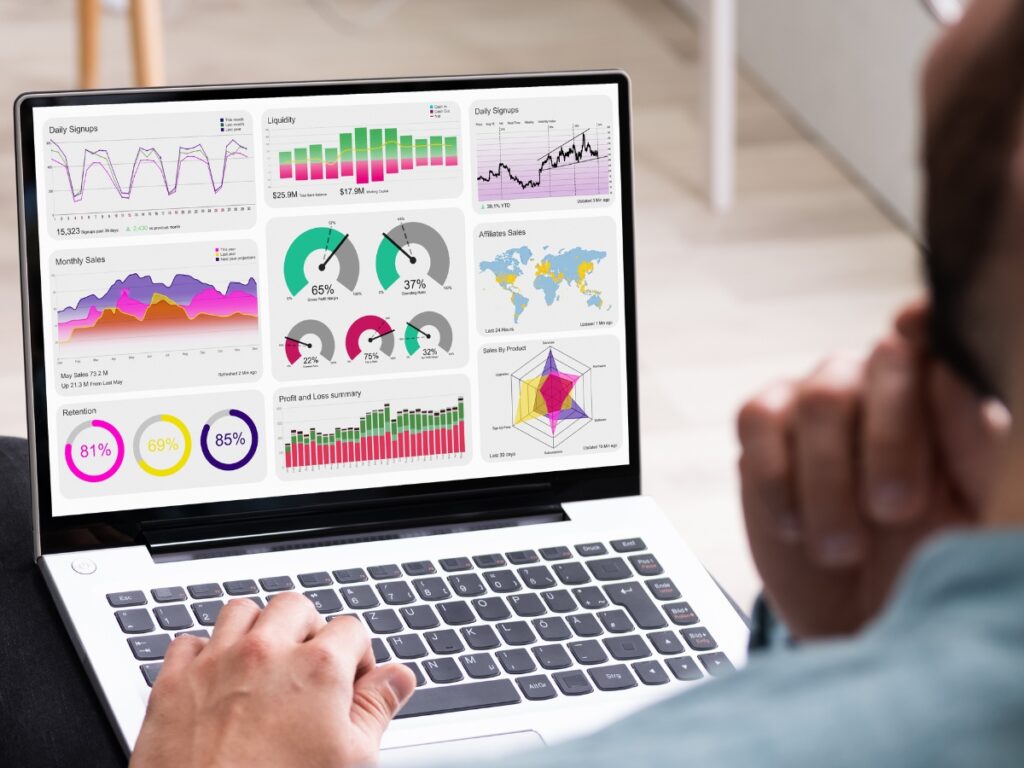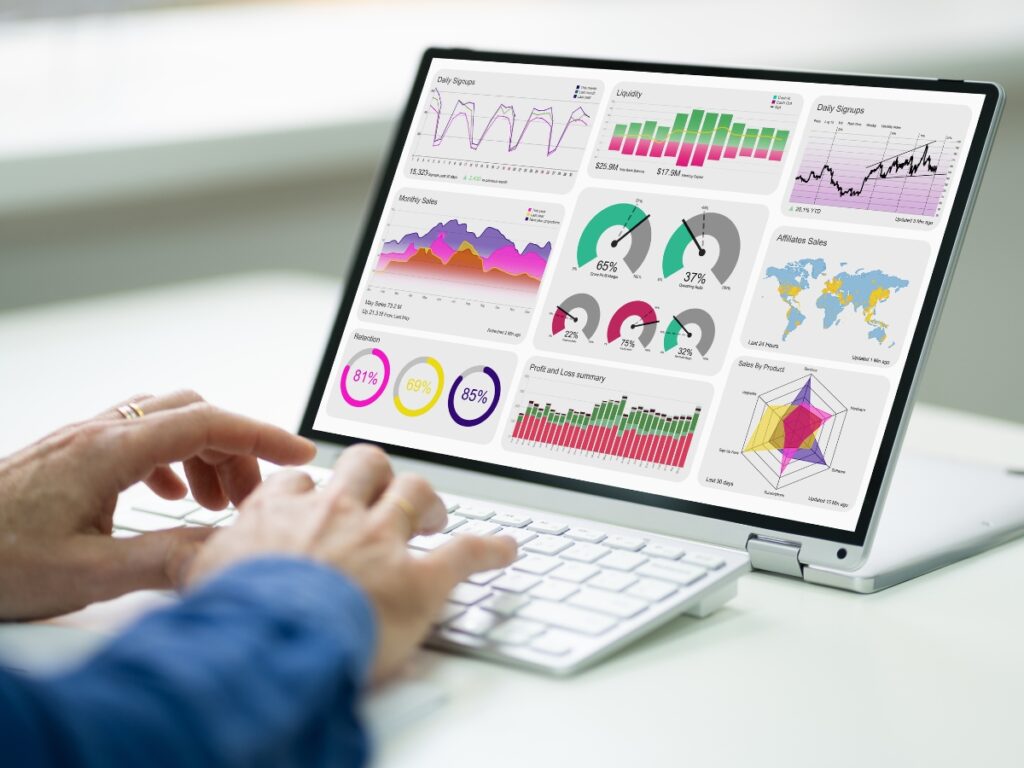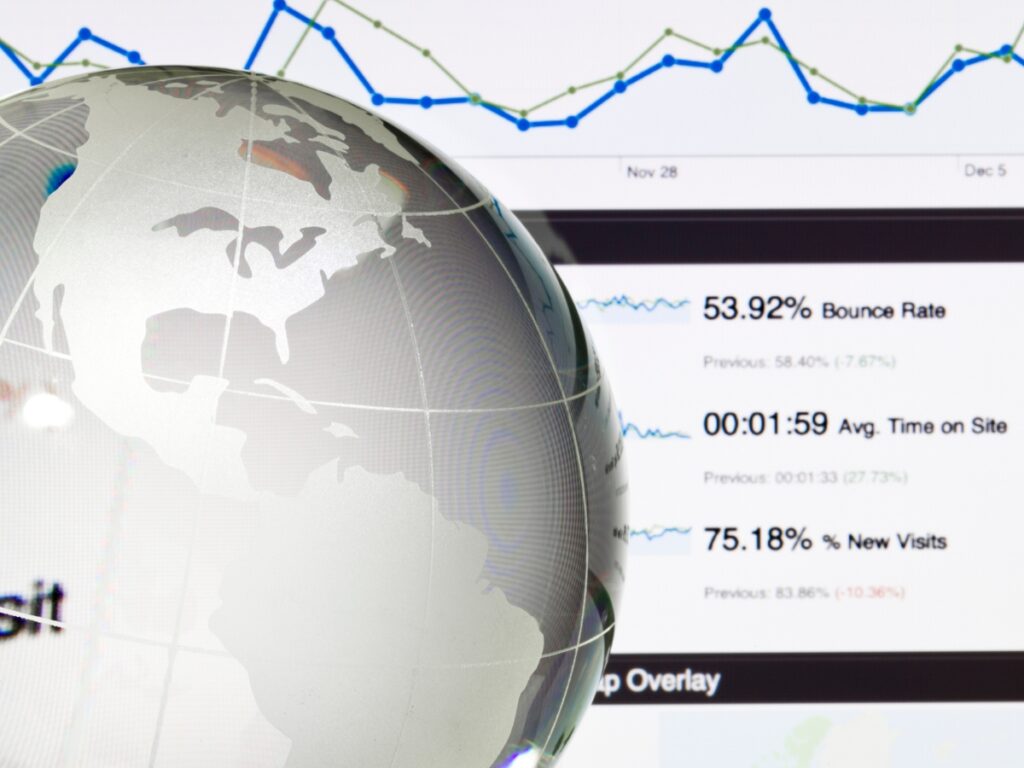Introduction: What Are The Best Google Analytics SEO Tools, and Why Are They Important?
In the competitive realm of SEO, Google Analytics SEO tools have emerged as indispensable assets for businesses worldwide. They comprehensively understand user behavior, helping marketers fine-tune their strategies for optimal visibility.
As we delve deeper into 2023, the importance of these tools in shaping data-driven decisions cannot be understated.
Welcome to the eighth article in the Blue Lane Group nine-part series on Overlooked SEO Tools for 2023: Comprehensive Strategies and Innovations for Dominant Digital Performance. This series covers all the essential SEO tools, concepts, and resources to optimize your blog posts and website.
As search engines advance, mastering SEO becomes not just essential but an art form. It’s not only about ranking high but also enhancing user experience. Load times and accessibility are crucial for user retention and reaching a wider audience. SEO matters for both the user and the search engine.
For bloggers and small business owners, SEO offers distinct challenges and opportunities. This series will provide targeted insights to boost your visibility and engagement.

Disclosure: The digital products mentioned in this article are highly regarded in the marketplace and are endorsed by the Blue Lane Group staff. We may earn a commission at no additional cost if you purchase through the provided links.
Table of Contents
The Crucial Connection: Why Google Analytics and SEO Go Hand-in-Hand
Harnessing the power of Google Analytics is more than just number crunching. This platform, which has become an industry standard, provides the metrics and insights SEO professionals need to refine their strategies, ensuring their content reaches its desired audience.
By diving deep into these metrics, sites can align their SEO efforts with real-time data, leading to higher visibility on Google and improved website performance.
Tracking Success: How Google Analytics SEO Tools Measure ROI
Google Analytics is no longer just about tracking page views or bounce rates. With the integration of SEMrush and Ahrefs as affiliate tools, SEO professionals can now assess their strategies’ return on investment (ROI) by connecting organic traffic growth to revenue generation.
When linked with Google Analytics, these tools offer a comprehensive view of how SEO tweaks directly affect conversions, guiding businesses on where to invest their efforts next.
Understanding User Behavior: Deep Insights from Google Analytics
User behavior is a treasure trove of insights for any SEO enthusiast. With Google Analytics, one can delve into user demographics, time on site, and the path they take through a website. By incorporating insights from tools like Moz Pro, you can leverage these behaviors to tailor your SEO strategy, ensuring you meet your audience’s needs and interests head-on.
Setting the Stage: The Growing Importance of Data-Driven Decisions
In an age where information is plentiful, making SEO decisions without data is akin to shooting in the dark. Google Analytics SEO tools have elevated decision-making by grounding it in actionable data.
Integrating with platforms like Ubersuggest allows businesses to understand the intricacies of their organic reach, ensuring every SEO choice is backed by solid, reliable information, propelling their content to the forefront of Google searches.

Deciphering the Dashboard: A Guided Tour of Google Analytics SEO Tools
Google Analytics SEO Tools isn’t just a platform; it’s a treasure trove of insights waiting to be unlocked. Understanding its multifaceted dashboard is crucial for SEO success, from affiliate marketers to enterprise-level businesses.
The better we grasp these tools, the more effectively we can refine our strategies, ensuring prime Google ranking and increased organic visibility.
Audience Overviews: Delving into User Demographics with Google Analytics SEO Tools
One of the most powerful features of Google Analytics SEO tools is segmenting and analyzing user demographics. Professionals can access invaluable data like age, location, device, and even interests with a click.
Tools like Optimizely can combine these demographic insights, allowing businesses to tailor content and campaigns to specific audience segments, boosting engagement and conversion rates.
Acquisition Insights: The Power of Traffic Source Discovery
Where is your traffic coming from? The Acquisition feature in Google Analytics SEO tools readily answers this vital question. Unearthing sources like direct traffic, referrals, organic searches, or even specific social media channels can be invaluable.
When paired with SE Ranking, these insights can help SEO professionals optimize their outreach, fine-tuning where and how they invest their efforts for the best returns.
Behavior Breakdown: Engaging Deeply with User Navigation Patterns
Understanding how users navigate and engage is paramount to genuinely optimizing a website. Google Analytics SEO tools’ Behavior feature provides insights into page views, bounce rates, and the pathways users take through a website.
This data, when synchronized with tools like Clicky, allows businesses to identify high-performing content and potential areas of improvement, ensuring users have a seamless and engaging experience from entry to exit.

Extensions and Enhancements: Expanding Google Analytics’ Capabilities
The realm of Google Analytics SEO tools is ever-evolving, offering a plethora of functionalities tailored to meet the changing needs of SEO experts. As businesses aim to attain the pinnacle of Google ranking in 2023, they lean heavily on extensions and enhancements to maximize their analytics’ potential.
Recognizing this need, Google has made available a range of add-ons and upgraded platforms, each promising to elevate the user experience and provide richer insights.
Google Analytics 4: The Next Evolution in SEO Tools
Google Analytics 4 (GA4) is not merely an update; it’s a total reimagining of what Google Analytics can be. Touted as the future of analytics, GA4 focuses on user-centric data, allowing for a more holistic understanding of user journeys.
Integrating with affiliate marketing tools like Ahrefs or SEMrush, GA4 offers a detailed look at search trends, enabling businesses to tailor their strategies with precision and foresight.
Google Tag Manager: Streamlining Tag Implementation
One often underutilized yet potent Google Analytics SEO tool is Google Tag Manager. This tool lets users deploy and manage website tags without modifying the code. Whether tracking conversions, monitoring site analytics, or integrating affiliate links via platforms like LinkWhisper, Google Tag Manager makes the process seamless, ensuring data accuracy and site performance remains uncompromised.
Data Studio: Visualizing Data and Crafting Reports
In the realm of data presentation and report creation, Data Studio stands as a beacon. An integral part of Google Analytics SEO tools, it transforms raw data into visually engaging and easily understandable reports.
When combined with analytics-focused plugins like MonsterInsights, businesses can derive actionable insights, present them in board meetings, or use them to shape affiliate marketing campaigns, ensuring stakeholders at all levels understand the SEO journey’s nuances.

Traffic Treasures: Using Google Analytics SEO Tools for Audience Analysis
Google Analytics SEO tools have always been a cornerstone for successful SEO professionals. Their capacity to unravel intricate audience dynamics is unparalleled. The rise of sophisticated analytics platforms underscores the importance of understanding one’s audience intricacies, making them indispensable for affiliate marketers and brands aiming for dominance in 2023.
Active Users and Cohort Analysis: Engaging Loyal Audiences and Recognizing Trends
Understanding the behavior and engagement levels of active users is paramount in SEO. To dive deep into this, Google Analytics introduces features like Active Users and Cohort Analysis. Active Users clearly show how many users consistently engage with a site over a specified period.
Meanwhile, Cohort Analysis, especially with affiliate platforms like ClickBank or ShareASale, allows tracking specific groups based on shared experiences, helping recognize patterns and trends that can shape future marketing strategies.
Interests Overview: Tailoring Content to Audience Preferences
One of the standout features of Google Analytics SEO tools is the Interests Overview. This tool sheds light on a website’s audience’s passions, needs, and habits, grouping users based on shared affinities. By understanding what interests one’s audience — technology, fitness, or fashion — businesses can tailor content more effectively.
With integration from content optimization tools like Yoast SEO, brands can leverage these insights to curate content that ranks higher and resonates deeply with their target audience.

Content Performance: Delving into Page and Post Metrics
Dive into the realm of Google Analytics SEO tools, and you’ll discover a treasure trove of insights that can transform how you perceive content performance. 2023 sees a heightened emphasis on quality content backed by accurate data to drive success.
Using these tools, affiliate marketers and brands can decipher which content assets shine the brightest and which require refinement.
Pageviews, Unique Pageviews, and Bounce Rate: The Core of Page Metrics
Regarding measuring content popularity, page views and Unique Pageviews are the backbone metrics in Google Analytics. Pageviews reflect the total number of times a specific page was viewed, while Unique Pageviews represent individual user visits, filtering out multiple views by the same user.
The Bounce Rate also indicates the percentage of users who land on a page and leave without navigating further. When interpreted using SEO platforms like SEMrush or Ahrefs, this trio can offer valuable insights into content appeal and areas of improvement.
Event Tracking: Measuring Specific User Actions
Google Analytics SEO tools elevate data tracking with their Event Tracking feature. This allows website owners to measure specific user actions, such as clicks on a button, video views, or downloads of a particular document.
This can be especially crucial for affiliate marketers when monitoring how users interact with affiliate links or call-to-action prompts. Tools like OptinMonster or MonsterInsights can seamlessly integrate with Event Tracking, providing a more holistic view of user behavior.
Session Duration and Pages/Session: Gauging Engagement Depth
In the era where user attention is a premium asset, metrics like Session Duration and Pages/Session become invaluable. Session Duration offers insights into the average time a user spends on a site, indicating how captivating the content is.
Meanwhile, Pages/Session highlights how many pages, on average, a user browses during a single visit. Integrating this data with content management systems like WordPress or tools like BuzzSumo allows brands to understand the content depth and user journey, optimizing for higher engagement and retention.

E-commerce Excellence: Google Analytics SEO Tools for Online Retailers
E-commerce continues to dominate the digital landscape in 2023, with Google Analytics SEO tools playing a pivotal role in deciphering the intricacies of online shopping behaviors. As online retailers juggle a myriad of components — from product listings to checkout optimization — harnessing the power of these tools can significantly bolster their sales and conversion strategy.
Leading e-commerce platforms, including Shopify and Magento, often integrate seamlessly with Google Analytics, allowing retailers to view their store’s performance comprehensively.
E-commerce Tracking: Monitoring Sales and Conversions
One of the primary tools in the arsenal of online retailers is E-commerce Tracking. This feature in Google Analytics provides an in-depth view of sales activity on a website.
This tool enables online store owners to monitor sales and conversion rates, from product performance and revenue generation to transaction details. When coupled with SEO platforms like SEMrush, it becomes easier to correlate organic traffic strategies with actual sales outcomes.
Shopping Behavior Analysis: Understanding the Purchase Process
The journey of an online shopper can be complex, with multiple touchpoints before a purchase is finalized. Google Analytics Shopping Behavior Analysis breaks down this journey, highlighting where users are dropping off and where they’re successfully moving forward in the purchase process.
This insight is invaluable for e-commerce sites looking to optimize the user experience, reduce cart abandonment, and boost conversions. Solutions like Hotjar can further provide visual representations of this behavior, allowing businesses to make informed tweaks to their online storefront.
Multi-Channel Funnels: Tracing Conversion Path
Understanding that users may interact with multiple marketing channels before purchasing is crucial for an omnichannel strategy. The Google Analytics Multi-Channel Funnels tool showcases the various touchpoints — organic search, paid ads, or social media — contributing to conversions.
This broader perspective is vital for retailers who utilize platforms like Facebook Ads or Google AdWords. Tracing the conversion path allows them to allocate resources efficiently, ensuring every channel plays its part in the conversion journey.

Goal Setting and Monitoring with Google Analytics
A successful SEO strategy is built on well-defined goals and continuous performance monitoring. Google Analytics SEO tools are indispensable for businesses defining, tracking, and optimizing their objectives.
By providing a granular view of user behavior, these tools enable brands to measure their strategies against concrete results. Digital marketing platforms like HubSpot and Moz often emphasize integrating Google Analytics’ insights into broader campaign strategies.
Defining Objectives: Setting up and Structuring Goals
Every digital strategy begins with a set of clear objectives. Google Analytics allows businesses to set and structure specific goals that resonate with their marketing and operational needs. Whether it’s increasing newsletter sign-ups, boosting product sales, or elevating webinar registrations, defining these objectives in Google Analytics offers a structured framework.
In tandem with SEMrush or Ahrefs, businesses can align their SEO efforts with these goals, ensuring a harmonized approach to digital growth.
Funnel Visualization: Mapping the Conversion Journey
Understanding the user’s journey toward conversion is crucial for optimizing touchpoints and eliminating roadblocks. The Funnel Visualization tool in Google Analytics provides a visual representation of this journey, allowing businesses to see where potential customers drop off and where they proceed successfully.
For e-commerce platforms, this can mean the difference between an abandoned cart and a successful sale. Paired with tools like Optimizely for A/B testing, businesses can refine and restructure these funnels for better results.
Event Goals: Quantifying Diverse User Actions
Beyond conventional conversions, modern websites interact with users in myriad ways. Event Goals in Google Analytics allow businesses to quantify these diverse user actions, whether a video play, a document download, or an interaction with an embedded tool.
Tools such as Crazy Egg can supplement these insights, offering heatmaps and session recordings. By understanding and quantifying these actions, businesses can better cater to their audience’s needs, ensuring a seamless and interactive digital experience.

Enhanced Link Attribution: Uncovering the Value of Every Click
Diving deep into the intricacies of user behavior on your website, Enhanced Link Attribution provides an advanced layer of insight crucial for SEO strategists. Businesses can craft a more intuitive and optimized user journey by understanding how users navigate and which links they engage with.
Platforms like Google’s Search Console and popular SEO tools such as Majestic emphasize the significance of link strategies, but integrating them with the insights from Google Analytics SEO tools adds another dimension to the analysis.
In-Page Analytics: Analyzing Click Patterns
One of the standout features of Enhanced Link Attribution is the In-Page Analytics function. This tool provides a visual breakdown of where users click on a page, revealing patterns, preferences, and potential areas of improvement.
By integrating insights from In-Page Analytics with tools like Screaming Frog, businesses can identify gaps in their site structure, content, or calls-to-action, refining their website for maximum user engagement.
Linking Ads: Synchronizing PPC and SEO Insights
While organic traffic remains a primary focus for many, the symbiotic relationship between pay-per-click (PPC) campaigns and SEO cannot be understated. By linking your Google Ads account with Google Analytics, you gain a unified view of your PPC and SEO performance.
When analyzed using tools like WordStream, this interplay helps businesses identify high-performing keywords, allocate budgets efficiently, and tailor their content strategy to what truly resonates with their audience. Companies can craft a more holistic and robust digital marketing strategy by harnessing organic and paid insights.

Customization and Segmentation: Tailoring Google Analytics to Your Needs
As businesses diversify and grow, the one-size-fits-all approach becomes increasingly inadequate. Google Analytics SEO tools allow for a highly personalized user experience, providing tailored insights that cater to a company’s unique needs and objectives.
With features such as Custom Reports and Advanced Segments, businesses can obtain data that speaks directly to their goals, ensuring informed decisions that drive growth. Integration with tools like SEMrush or Moz can further refine this experience, allowing businesses to cross-reference Google Analytics data with external metrics.
Custom Reports: Building Tailored Data Views
Custom Reports stand out as a beacon for businesses looking for precise, relevant information in the vast ocean of data that Google Analytics provides. Instead of sifting through pre-set reports and trying to locate relevant metrics, Custom Reports allow users to build their dashboards, focusing on the data points that matter most to them.
This function becomes even more potent when integrated with platforms like Tableau, enabling a visual representation of your data and leading to more intuitive insights and actionable strategies.
Advanced Segments: Isolating Specific User Behaviors
Every user is unique, but patterns emerge in how different segments of users interact with a website. Advanced Segments in Google Analytics SEO tools let businesses isolate and analyze these patterns, from regional behaviors to device-specific interactions.
This granular view, especially when synchronized with platforms like Optimizely for A/B testing, allows businesses to fine-tune their strategies, catering to different user groups’ nuanced needs and preferences. The result? Enhanced user satisfaction and increased chances of conversion.

Alerts, Integrations, and Automation: Staying Proactive with Analytics
In today’s fast-paced digital landscape, it’s not enough to merely react to trends; businesses must be proactive. Google Analytics SEO tools are designed not just for retrospective analysis but also for forward-thinking actions.
Tools like Custom Alerts, API Integrations, and Scheduled Reports enable businesses to stay ahead, making real-time decisions while integrating seamlessly with other platforms. This proactive approach, complemented by insights from affiliate SEO tools like Ahrefs and Majestic, ensures that businesses stay ahead of the curve.
Setting Up Custom Alerts: Receiving Instant Notifications
Awareness is the first step toward action. With Google Analytics Custom Alerts, businesses can be instantly notified of any significant changes in their metrics, from traffic spikes to unusual bounce rates. This ensures companies react quickly, capitalizing on positive trends or mitigating potential issues.
Businesses can have a holistic view and action plan when paired with responsive SEO tools like Screaming Frog.
API Integrations: Enhancing Platform Connectivity
The power of Google Analytics SEO tools is amplified when integrated with other platforms. Through API Integrations, businesses can seamlessly merge data from multiple sources, creating a comprehensive overview of their online performance.
For instance, integrating with tools like Kissmetrics or Mixpanel can provide deeper insights into user behavior, facilitating a richer understanding and more informed strategy development.
Scheduled Reports: Periodic SEO Insights Delivery
Scheduled Reports are a game-changer for businesses with vast teams or those operating across different time zones. Instead of manually extracting data, Google Analytics can be set up to deliver tailored reports at specified intervals, ensuring that all stakeholders receive timely and relevant insights.
When synchronized with detailed analysis from SEO tools like SE Ranking, this automation provides businesses with a continuous stream of actionable intelligence, driving consistent growth and refinement.

Safety and Security: Protecting Data within Google Analytics
In the era of cyber threats and stringent data regulations, ensuring the safety and security of user data is paramount. Google Analytics SEO tools have features designed to protect, refine, and manage the data that flows into the platform.
By integrating these features with robust affiliate tools like Sucuri and Cloudflare, businesses can fortify their data safety measures while still deriving the essential SEO insights they need.
Filter Configurations: Cleaning and Refining Data Input
Filters in Google Analytics play a dual role: they refine the data for better insights and protect it from potential spam or malicious inputs. By setting up precise Filter Configurations, businesses can exclude irrelevant traffic, such as internal visits, while safeguarding against referral spam.
This creates a cleaner, more accurate data set ready for deeper analysis with tools like Moz or Semrush.
User Permissions: Access Management and Control
Ensuring that only the right individuals can access specific data is essential in preserving its integrity. Google Analytics allows businesses to set User Permissions, tailoring who can view, edit, or administer the platform.
This tiered access system ensures that sensitive data remains confidential, and when combined with monitoring tools like LastPass for password security, businesses can maintain tight control over their analytics.
Data Retention and GDPR: Regulatory Compliance in Data Storage
With the advent of the GDPR and other data protection regulations, it’s essential to ensure that stored data complies with international standards. Google Analytics offers settings for Data Retention, allowing businesses to specify how long data is held before automatic deletion.
Furthermore, the platform provides tools to help businesses adhere to GDPR guidelines, ensuring user data is stored responsibly. Companies can confidently navigate the complex regulatory landscape when used alongside compliance management platforms like OneTrust.

Looking Ahead: The Future of Google Analytics SEO Tools
The digital landscape is ever-evolving; the tools we use to analyze and understand this vast terrain must also advance. At the forefront of this digital revolution, Google consistently refines its Google Analytics SEO tools, introducing more sophisticated features and insights.
With the integration of AI technologies and advanced algorithms, the future of Google Analytics promises more profound, more predictive insights that will empower businesses to craft strategies with unparalleled precision.
Predictive Metrics: Forecasting User Behavior
Predictive analytics, powered by advanced machine learning, is set to become a cornerstone of Google Analytics. These predictive metrics aim to forecast user behaviors, giving businesses a glimpse into potential future trends and consumer actions.
With affiliate tools like DataRobot or RapidMiner enhancing these capabilities, marketers can leverage these insights to design campaigns that resonate with emerging patterns and preferences.
Cross-Platform Analysis: Integrating Diverse Data Streams
As businesses expand their digital footprint across various platforms, having a unified view of their performance metrics becomes vital. Google Analytics is heading towards more seamless cross-platform analysis, integrating data from diverse sources like apps, social media, and IoT devices.
Tools such as Supermetrics can further amplify this integration, pulling data from multiple platforms into Google Analytics for a holistic overview.
Staying Updated: The Ongoing Evolution of Google’s Tools
Google is known for its continuous innovation, and its analytics platform is no exception. As new digital behaviors emerge and the digital ecosystem expands, Google Analytics will continue to evolve, introducing new features and refining existing ones.
Users can stay abreast of these updates by integrating with continuous learning platforms like Coursera or Udacity, ensuring they’re constantly leveraging the full power of Google’s SEO tools.

In Conclusion: Thoughts on Google Analytics SEO Tools
The dynamic world of SEO is constantly evolving, and Google Analytics SEO tools stand out as crucial instruments for businesses striving for online success. With its decadent array of features, from audience analysis to predictive metrics, Google Analytics offers deep insights that help shape data-driven strategies.
Its adaptability, integration capabilities, and emphasis on future enhancements highlight its ongoing relevance in the digital landscape. As we venture further into 2023 and beyond, harnessing the power of these tools becomes even more imperative.
Staying updated with the latest Google Analytics developments will ensure brands remain competitive and resonate with their target audiences.
You Might Also Like:
If you enjoyed this article and received value from it, check out the other Blue Lane group articles in the Overlooked SEO Tools for 2023: Comprehensive Strategies and Innovations for Dominant Digital Performance series:
- Unlocking Growth: Essential SEO Organic Traffic Tools for 2023
- Elevate Your Online Presence: Discover the Best SEO Link Building Tools of 2023
- Empowered Entrepreneurs: Top Local SEO Tools for Small Businesses in 2023
- Inspiring Content: Essential SEO Tools for Bloggers in 2023
- Powering Your Platform: Best SEO Plugins for WordPress in 2023
- Revolutionize Your Analysis: Top AI Keyword Research Tools for 2023
- Proven Success: Optimal SEO Tools for Loading Speed in 2023
- Mastering Metrics: Best Google Analytics SEO Tools for 2023
- Rise to the Top: Proven SEO Strategies for Google Ranking in 2023





